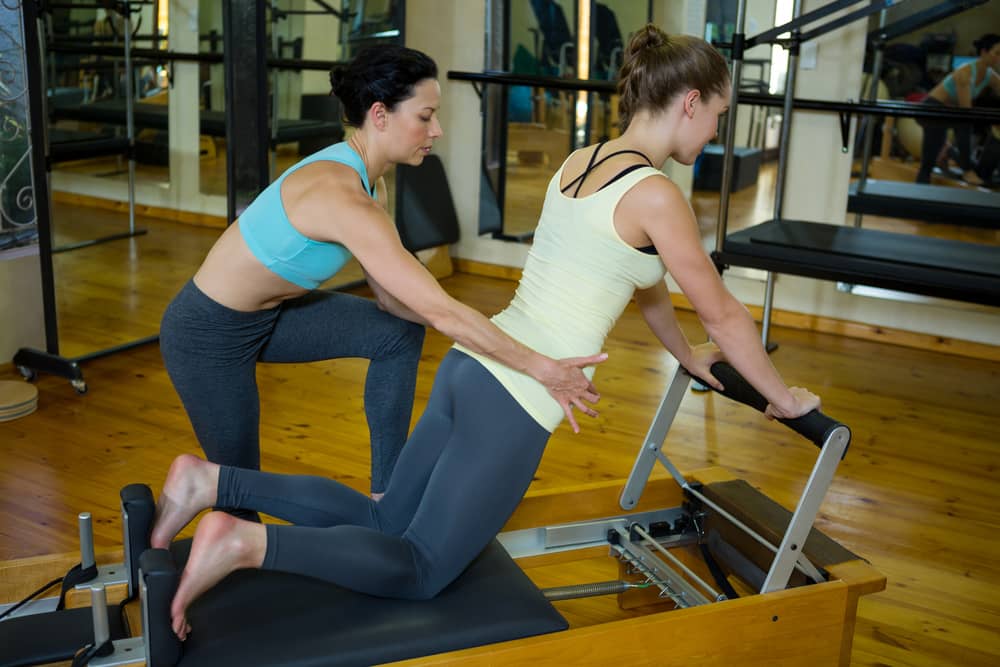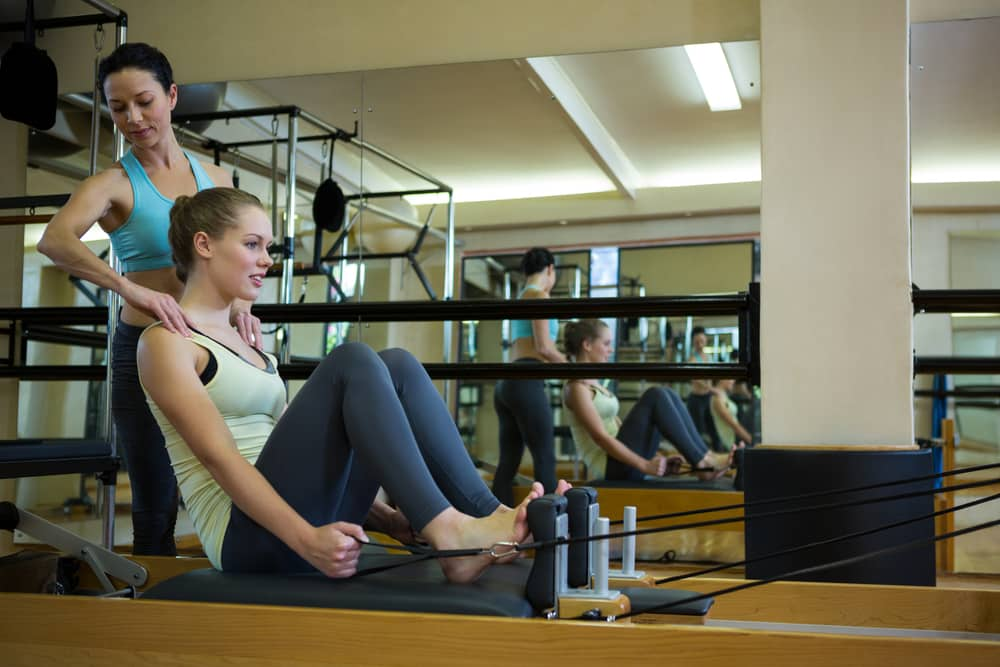Pilates requires practice to perfect. And without proper knowledge or instruction, beginners can easily make Pilates reformer workout errors.
The best way to go about it is to know what these common mistakes are and how to correct them. This list should give you a pointer or two to improve your routine.
1. Unstable Tail or Pelvis
Beginners would often lift their bottom off the Pilates reformer platform when working their legs with the straps. This habit is incorrect.
Your goal is to keep your pelvis steady, whether you’re doing a neutral or imprinted placement.
Neutral is when you have both feet on the platform. Here, you maintain the natural curve of your lower back.
Now, there should be a slight tuck on your pelvis as you move your feet off the carriage. Your lower back should be touching the platform more as well. We call this the imprint.
Solution: The personal trainer should teach you the correct pelvic placement from the get-go.
Imagine balancing a bowl of soup on your pelvis and preventing it from spilling when learning this technique.
Also, aim for a 90-degree angle tabletop position for your hips and knees.
2. Incorrect Level of Resistance
Before starting your Pilates reformer workout, you must adjust its springs according to your exercise.
Otherwise, you may not feel comfortable or get the intended results.
These springs let you increase or decrease the resistance for balance and support.
So, make sure you know when to add or lessen it when necessary.
Solution: Ask your Pilates instructor about correct levels of resistance. You can also look for Pilates reformer exercises with proper spring tension settings.
3. Improper Spine Alignment
Whether you are standing up, side bending or lying down, keep the natural arch of your lumbar region.
Your spine should not be pressing down on the platform. And when side bending, your arms and shoulders should not round forward.
Keeping a neutral spine ensures strain and injury prevention of the lower back and neck.
Solution: If you are standing or lying down, keep your spine aligned down to your waist.
Also, use the platform extender to align your hips and back when doing lateral flexion.

4. Unnatural Breathing Technique
You may think that proper breathing during exercise is not that essential.
But in Pilates, it is a technique you need to master to ensure that you’re using the correct muscles.
It’s an understandable mistake among newbies.
You see, when you need to concentrate and learn a lot in one go, you are more likely to hold your breath involuntarily.
And while it’s normal, your Pilates reformer workout feels uncomfortable if you’re too tense.
Your movements do not flow naturally either.
You’ll also notice that doing Pilates in a hurry makes you breathe less often.
That’s a clear sign that you need to modify your speed and breathing.
Solution: This error needs some practice to correct. Breathe freely and mindfully, and keep your body relaxed.
Some reformer class instructors also offer breath coaching. This way, they can observe your routine and offer guidance.
Remember to inhale and exhale with each twist or turn. And don’t hesitate to push the air out loudly to release tension.
5. Wrong Pacing
Pilates is all about controlled and precise movements. It’s not a competitive sport.
And so, if you’re fond of doing vigorous exercise, you might find a Pilates reformer workout strange.
But despite the slower movements, it doesn’t mean that Pilates is less challenging.
Precision is crucial in achieving the proper form and ensuring that you are using the correct muscles.
Now, keep in mind that Pilates is different from yoga. While both require slow motions, you don’t need to hold your position for long periods during Pilates.
Solution: If you’re a Pilates beginner, it’s best to do it with instructors. That way, they can assess your form, speed and breathing.
At home, you can ask someone who knows the exercise to evaluate your moves, too.
Also, remember that with Pilates, quality is more important than quantity.
6. Overworked Shoulder Muscles
When doing arm exercises during your Pilates reformer workout, you might be gripping in your upper traps a little too much.
These are the muscles in between your shoulder blades.
We often use these muscles to do our day-to-day activities. That’s why putting so much stress on them during Pilates class will only result in neck tension and pain.
Solution: Keep your upper body and shoulders relaxed. Your shoulder blades should remain flat against your ribcage.
Also, try learning how to engage your lower traps more during exercise.

7. Too Big Movements
We all know the saying “no pain, no gain”. If we don’t feel a burn, we are not making any progress. But Pilates is different.
While certain moves can make your muscles burn, some are “too mild” that you won’t feel anything.
However, that doesn’t mean you are wasting time.
A Pilates reformer workout mainly focuses on your small and deep muscles. The idea is to warm them up first before going to the next level.
Solution: Keep going and be patient. Training tiny muscles take time and continuous effort.
You can ask your instructor about certain Pilates moves and what you should be feeling after.
But remember, your priority is to perform the exercises correctly.
Takeaway
Pilates is an excellent form of exercise. But you might be missing out on its benefits if you do not perform the moves correctly.
So, start with the assistance of a personal trainer and master the basics first. More importantly, don’t give up after a Pilates class or two.
Keep at it, and you’ll see why people love their Pilates reformer workout routine.
Once you’re confident enough to do Pilates at home, add a reformer to your home gym!
Check out this reformer machine buying guide to learn more.
- Foldable vs Traditional Reformers: Which One’s Right for You? - 2 July 2025
- Elliptical Cross Trainer vs Exercise Bike: Which is Better? - 24 June 2025
- How Do the Different Massage Gun Attachments Work? - 23 June 2025
